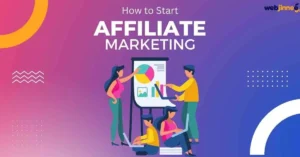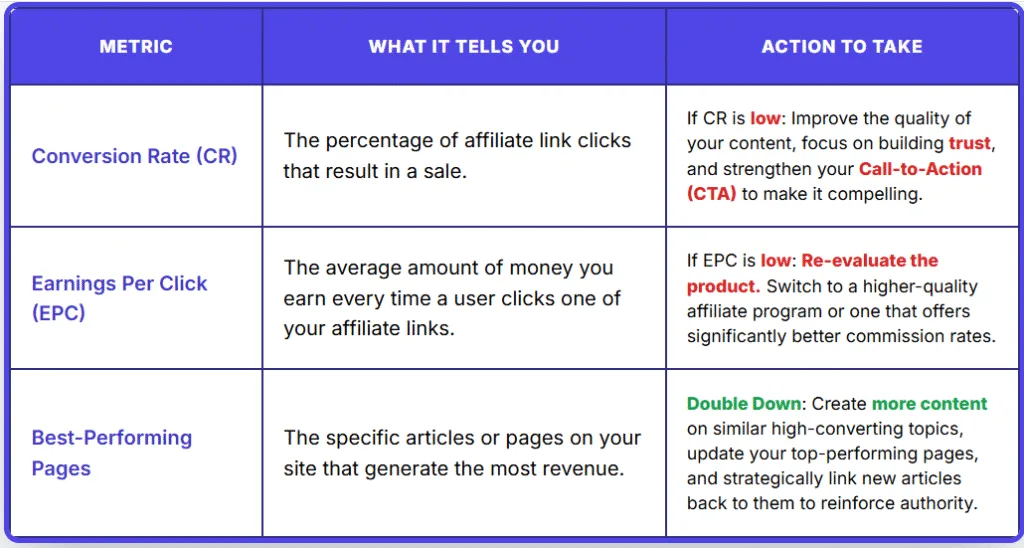
The 7-Step Roadmap: How to Start Affiliate Marketing for Absolute Beginners
Introduction
Are you ready to earn passive income online and finally break free from trading time for money? Affiliate marketing is the business model that makes it possible. If you’ve been searching “how to start affiliate marketing,” you’ve found the definitive resource. In this step-by-step beginner’s guide, we’ll walk you through the entire process, from choosing a niche to getting your first commission check. By the end, you will have a clear, seven-step roadmap to launch your successful affiliate business.
Step 1: Choose a Profitable Niche and Define Your Target Audience
Before diving into affiliate marketing, it’s crucial to select a niche that aligns with your interests, knowledge, and target audience. Choosing a niche allows you to focus your efforts on a specific market segment, enabling you to become an authority in that area. Here are some tips to help you choose the right niche: Identify your passions: Start by making a list of topics you are passionate about. This could be anything from fitness and wellness to technology or fashion.
Identify your passions: Start by making a list of topics you are passionate about. This could be anything from fitness and wellness to technology or fashion.
Research profitability: While it’s essential to choose a niche you enjoy, it’s equally important to consider its profitability. Conduct thorough research to determine if there is a demand for products or services within your chosen niche.
Analyze competition: Look into the competition within your niche. Assess their strategies, identify gaps, and find unique angles to differentiate yourself in the market.
Step 2: Build Your Primary Platform (Blog, YouTube, or Social Media)
Once you have chosen your niche, the next step is to build a platform where you can promote affiliate products or services. Your platform could be a website, blog, social media account, or YouTube channel. Here’s how you can get started:

Setting Up Your Affiliate Hub (Website Checklist)
Setting up a website provides you with a professional and centralized platform to share valuable content and promote affiliate products. Follow these steps to create your website:
Choose a domain name: Select a domain name that reflects your niche and is easy to remember.
Select a web hosting provider: Research and select a reliable provider for speed, security, and high uptime. A reliable host is the foundation of your affiliate business.
Install a content management system (CMS): Popular CMS options include WordPress, Joomla, and Drupal. Choose one that suits your needs and install it on your hosting account.
Customize your website: Select a theme or design that aligns with your niche and customize your website to create a visually appealing and user-friendly experience.
Step 3: Create High-Value Content That Drives Trust and Conversions
Compelling and informative content is the backbone of a successful affiliate marketing strategy. By providing valuable information to your audience, you can establish yourself as a trusted authority and increase the likelihood of conversions. Here are some content ideas to get you started:
Product reviews: Write detailed and unbiased reviews of products or services within your niche, highlighting their features, benefits, and drawbacks.
Tutorials and guides: Create step-by-step tutorials or guides that help your audience solve a problem or achieve a goal related to your niche.
Comparison articles: Compare different products or services within your niche, highlighting their pros and cons to help your audience make informed decisions.
Step 4: Find and Join the Best Affiliate Programs
Once you have your niche and platform ready, your next crucial step is finding products to promote. You need to connect with businesses that offer high-quality products or services and have affiliate programs that pay well.
Focus on Two Types of Programs:
1. Affiliate Networks (The Gateway): These are large platforms that host thousands of programs under one roof. They are the best starting point for beginners as they handle all the tracking, payments, and reporting in one dashboard.
- Examples: ShareASale, CJ Affiliate (Commission Junction), and Awin.
2. In-House/Direct Programs (The Niche Specialist): Many established brands run their own affiliate programs. You apply directly through their website.
- Strategy: Search for your niche’s top companies and check their footer for a link labeled “Affiliates,” “Partners,” or “Referral Program.”
Choosing the Right Program:
When selecting a program, ask yourself:
- Relevance: Does the product truly solve a problem for my audience?
- Commission: What is the payout? (Look for at least 10% to 50% for digital products).
- Cookie Duration: How long does the affiliate link track a referral? (Longer is better).
Step 5: Master the Art of Ethical Promotion (Link Placement and Disclosure)
To build trust and stay compliant with regulatory bodies like the FTC (Federal Trade Commission), your promotional strategy must be ethical and transparent. This step is non-negotiable for long-term success.
1. Mandatory Disclosure
You must clearly and conspicuously tell your audience that you earn a commission if they buy through your link. This disclosure should be:
- Above the Fold: Visible before the user has to scroll.
- Clear Language: Use phrases like: “This post contains affiliate links. If you make a purchase, I may earn a commission at no extra cost to you.”
- On Every Page/Video: The disclosure must be present wherever an affiliate link appears.
2. Link Placement and Tagging
- Place Links Naturally: Embed links within genuinely helpful reviews, tutorials, or comparison guides, not just in large blocks of text.
- Use Proper HTML Tags: For SEO, every affiliate link must use the
rel="sponsored"attribute (orrel="nofollow"if sponsored isn’t available). This tells Google that you are being paid for the promotion and that the link shouldn’t pass SEO “authority.”
Step 6: Drive Targeted Traffic to Your Content
Your affiliate links won’t earn anything unless people are reading the content that holds them. This step is about getting the right eyes on your work.
1. Search Engine Optimization (SEO)
Since you are writing a blog, SEO is your most powerful tool for passive income.
- Keyword Intent: Focus your content around “Buyer Intent” keywords (e.g., “Best review of X product,” “X vs. Y comparison,” “X product discount code”). These searchers are very close to making a purchase.
- On-Page SEO: Ensure your primary keyword is in your Title, H1, Meta Description, and image alt-text.
2. Leverage Email Marketing
For high-ticket or complex products, email is critical for success.
- Nurturing: Collect emails by offering a valuable lead magnet (e.g., a free checklist or mini-eBook).
- Build Trust: Send a sequence of emails that provide value, share your personal experience with the product, and slowly guide the subscriber toward the affiliate offer.
Step 7: Track, Analyze, and Scale Your Results
Affiliate marketing is a data-driven business. You must know what content is generating commissions and what’s just generating clicks.
1. Implement Tracking Tools
- Google Analytics (GA4): Use this to track website traffic, user behavior, and which pages people spend the most time on.
- Affiliate Dashboard: Cross-reference your GA data with the reports inside your affiliate networks to see exactly which link is converting.
2. Analyze Key Metrics
Frequently Asked Questions
1: How much money can I make with affiliate marketing?
The amount of money you can make with affiliate marketing varies based on factors such as your niche, marketing strategies, and the quality of your content. While some affiliates earn a few hundred dollars per month, others make substantial six-figure incomes. It ultimately depends on your dedication, effort, and ability to provide value to your audience.
2: How do I find affiliate programs to join?
There are several ways to find affiliate programs. You can start by researching popular affiliate networks such as Amazon Associates, ClickBank, and ShareASale. Additionally, many individual companies offer affiliate programs, so consider reaching out to brands directly within your niche.
3: Do I need a large following to be successful in affiliate marketing?
While having a large following can certainly help, it’s not the sole determinant of success in affiliate marketing. What matters most is the quality of your audience and their engagement with your content. Building a loyal and targeted audience, regardless of size, can lead to better conversions and higher earnings.
4: How do I disclose my affiliate relationships?
It’s essential to be transparent with your audience about your affiliate relationships. Disclose your affiliations by including a clear disclaimer in your content, stating that you may receive a commission for purchases made through your affiliate links. Additionally, ensure compliance with the Federal Trade Commission (FTC) guidelines or any relevant regulations in your country.
5: Can I do affiliate marketing without a website?
While having a website offers numerous advantages, such as increased credibility and control over your content, it is possible to do affiliate marketing without a website. You can leverage social media platforms, YouTube channels, or email marketing to promote affiliate products. However, keep in mind that having a website provides a more robust foundation for long-term success.
6: How long does it take to see results in affiliate marketing?
Affiliate marketing is not a get-rich-quick scheme, and it takes time and effort to see significant results. The timeline varies for each individual, but generally, it can take several months to a year of consistent effort before you start seeing substantial income. Patience, perseverance, and continuous learning are key.
Conclusion – Your Affiliate Marketing Journey Starts Now
You now have the complete seven-step roadmap for how to start affiliate marketing. Remember that success is built on two pillars: consistency and trust. Start by choosing a niche you can genuinely serve, build your platform with valuable content, and always disclose your affiliate relationships. With dedication and the strategies outlined here, you can turn your platform into a powerful, passive income engine. What is the first niche you plan to choose?
If you’ve chosen a niche, your next move is to read our guide on the 5 best affiliate networks for beginners to jump straight into Step 4!

